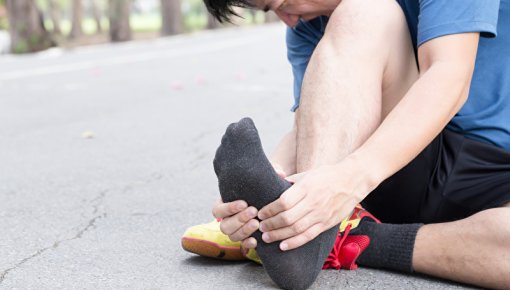Butterworth PA, Landorf KB, Smith SE, Menz HB. The association between body mass index and musculoskeletal foot disorders: a systematic review. Obes Rev 2012; 13(7): 630-642.
David JA, Sankarapandian V, Christopher PR et al. Injected corticosteroids for treating plantar heel pain in adults. Cochrane Database Syst Rev 2017; (6): CD009348.
Gutteck N, Schilde S, Delank KS. Plantarer Fußschmerz. Dtsch Arztebl Int 2019; 116(6): 83-88.
Institute for Quality and Efficiency in Health Care (IQWiG, Germany). Extracorporeal shock wave therapy (ESWT) for heel pain: Final report; Commission N15-06. 2017.
Klein C. Orthopädie für Patienten: Medizin verstehen. Wirbelsäule, Halswirbelsäule, Brustwirbelsäule, Brustkorb, Lendenwirbelsäule, Schulter, Ellenbogen, Hand, Hüfte, Knie, Fuß. Remagen: Michels-Klein; 2014.
MacRae CS, Roche AJ, Sinnett TJ, O'Connell NE. What is the evidence for efficacy, effectiveness and safety of surgical interventions for plantar fasciopathy? A systematic review. PLoS One 2022; 17(5): e0268512.
Petraglia F, Ramazzina I, Costantino C. Plantar fasciitis in athletes: diagnostic and treatment strategies. A systematic review. Muscles Ligaments Tendons J 2017; 7(1): 107-118.
Salvioli S, Guidi M, Marcotulli G. The effectiveness of conservative, non-pharmacological treatment, of plantar heel pain: A systematic review with meta-analysis. Foot (Edinb) 2017; 33: 57-67.
Wang YC, Chen SJ, Huang PJ et al. Efficacy of Different Energy Levels Used in Focused and Radial Extracorporeal Shockwave Therapy in the Treatment of Plantar Fasciitis: A Meta-Analysis of Randomized Placebo-Controlled Trials. J Clin Med 2019; 8(9): 1497.
IQWiG health information is written with the aim of helping people understand the advantages and disadvantages of the main treatment options and health care services.
Because IQWiG is a German institute, some of the information provided here is specific to the German health care system. The suitability of any of the described options in an individual case can be determined by talking to a doctor. informedhealth.org can provide support for talks with doctors and other medical professionals, but cannot replace them. We do not offer individual consultations.
Our information is based on the results of good-quality studies. It is written by a team of health care professionals, scientists and editors, and reviewed by external experts. You can find a detailed description of how our health information is produced and updated in our methods.


